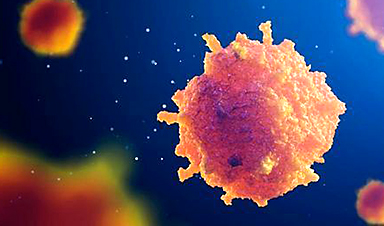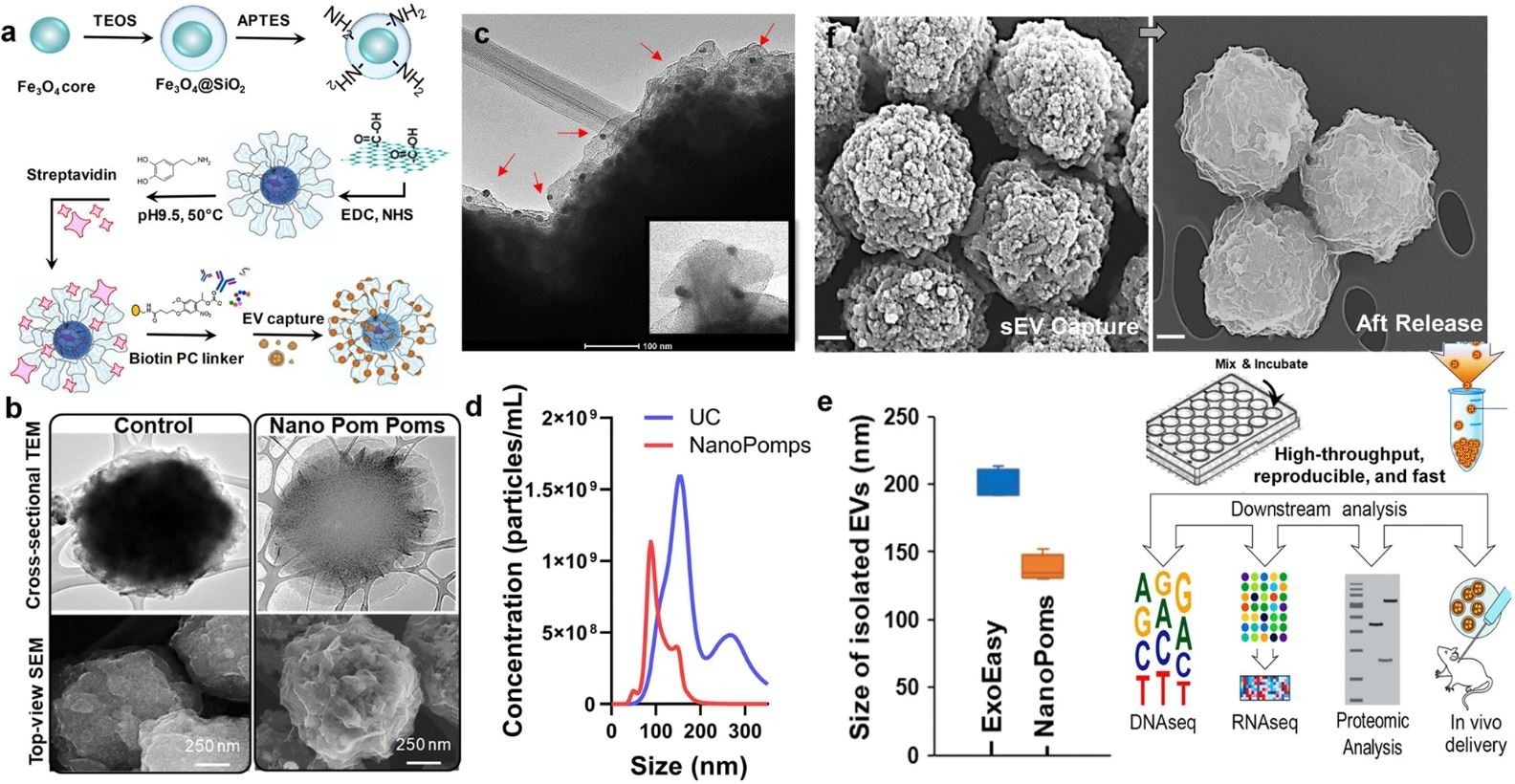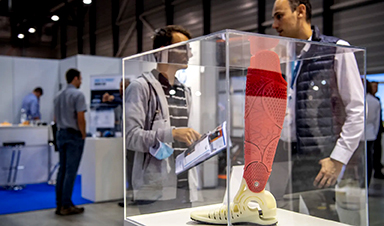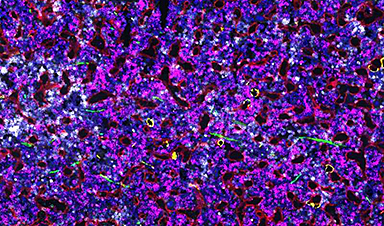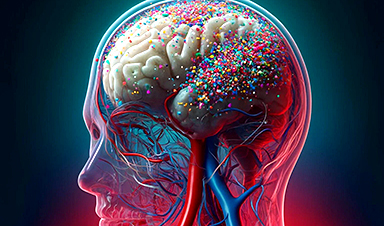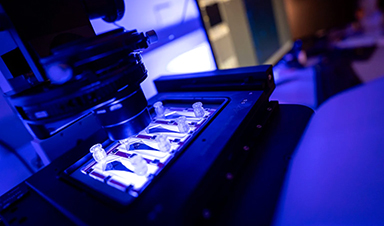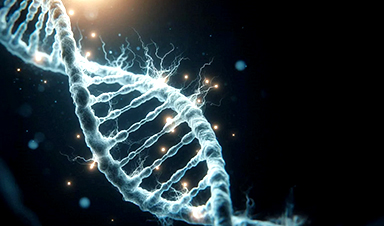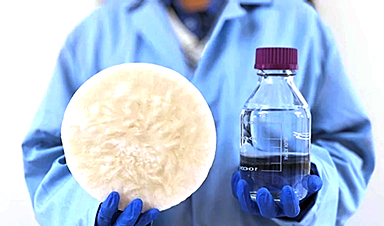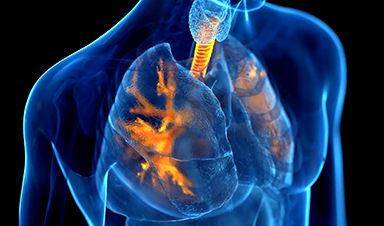Nanosized extracellular vesicle (EV) exosomes serve as reliable biomarker sources. However, cancer biomarker identification through exosome multi-omic molecular information mapping is challenging due to heterogeneous populations of exosomes derived from diverse cell types.
In an article published in the journal Communications Biology, researchers introduced novel three-dimensional (3D) nanographene immunomagnetic particles for specific capture and release (defined by marker) of the intact exosome. The designed novel 3D-structured nanographene particles had a unique morphology of flower pom-poms.
Moreover, the capture and release of intact exosomes were via photo-click chemistry. This exosome isolation approach allowed the identification of cancer biomarkers with enhanced sensitivity and specificity. The multi-omic exosome analysis for cancer biomarker identification was performed using tissue fluids obtained from a bladder cancer patient.
The nanographene immunomagnetic particles prepared exosomes showed a distinct in vivo biodistribution, indicating integral quality with high viability. This nanographene immunomagnetic particles-based technique is a facile approach applicable to various biological fluids. Amending the developed method facilitates scale-up, enrichment, and high-throughput exosome isolation.
What are Cancer Biomarkers?
Despite continuous efforts to develop cancer biomarkers, only a few are approved clinically by the United States Food and Drug Administration (USFDA), including progesterone receptor (PR), human epidermal growth factor receptor 2 (HER-2/neu), cancer antigen 125 (CA-125), and prostate-specific antigen (PSA).
EVs are emerging biomarker sources explored to discover a wide range of cancer biomarkers to achieve cancer diagnosis, drug target and delivery, and immunotherapy. Exosome-type small EVs and their molecular components are associated with various physiological functions and disease pathologies. The exosomes are secreted from tumor cells and are enriched with tumor markers. Consequently, their presence increases in plasma and ascites of the patients diagnosed with cancer.
Body fluids contain different types of EVs. Hence, cellular-specific homogenous exosome populations are not attainable. The cell-secreted membrane vesicles (EVs) are heterogeneous in origin, present in multiple subpopulations, in the broad size range of 30 to 1000 nanometers. Thus, due to the heterogenicity in vesicles and their overlapping size ranges, the exact cellular origin of the exosomes cannot be identified to understand the disease pathogenesis.
The existing purification methods utilized to recover extracellular materials (EMs) with vesicle or non-vesicular molecules include ultracentrifugation-based (UC) precipitation and precipitation polymer kits. However, these approaches are not scalable, and the exosome populations originating from different cell types or EV subtypes cannot be differentiated. Studying cancer biomarkers from exosomes derived from cancer cells is therefore challenging.
Nanographene Exosomes Towards Specific Cancer Biomarker Detection
The present study demonstrated a novel approach for specific capture and release of the intact exosomes that utilizes 3D-structured nanographene immunomagnetic particles. These nanographene immunomagnetic particles have a flower pom poms-like morphology, and the exosome capture and release mechanisms were based on photo-click chemistry.
The intact exosomes for the present study were isolated from different biological fluids, including human urine and blood, cow milk, and cell culture medium. Furthermore, the isolation of exosomes via nanographene immunomagnetic particles facilitated the effective identification of cancer biomarkers with high sensitivity and specificity compared to those isolated via immunomagnetic beads.
The in vivo biodistribution was tested for the exosomes released from nanographene immunomagnetic particles. The results showed distinct biodistribution patterns with insignificant alterations in surface properties of the exosomes, implying the potential of nanographene immunomagnetic particles in therapeutic development.
The exosomes derived from bladder cancer tissue fluids (urine and plasma) were compared with those derived from tumor tissues by next-generation sequencing (NGS) of miRNAs, global proteome, and somatic DNA mutations to achieve an invasive and ultra-sensitive diagnosis of bladder cancer.
The results revealed that compared to ultracentrifugation or bead isolation approaches, exosomes isolated from nanographene immunomagnetic particles showed improved sensitivity and specificity toward detecting urological tumor biomarkers.
The impact of external stimuli like the light release was observed on exosome isolation via a nanographene immunomagnetic particles-based approach in which miRNA profiles were compared in the presence and absence of the light release process. The light release process exhibited specificity by only releasing captured exosomes. These observations confirmed the quality and integrity of nanographene immunomagnetic particles-prepared exosomes as a robust and facile method.
What did the Study Find?
To summarize, the exosome isolation via nanographene immunomagnetic particles-based method was applied to various biological fluids, including human urine and blood, cell culture medium, and cow’s milk. This isolation method was simple and did not require an additional ultracentrifugation process.
The 3D structure of nanographene immunomagnetic particles and the regulated capture-release process by specific markers helped prepare homogenous exosome subpopulations that could enrich the cancer biomarkers.
The NGS and droplet digital polymerase chain reaction (ddPCR) demonstrated that DNA isolation from nanographene immunomagnetic particles-prepared exosomes could be enriched for DNA mutations in bladder cancer-relevant tumors and help in cancer biomarker identification.
News
Breakthrough for long Covid patients who lost sense of smell
A breakthrough nasal surgery has restored the sense of smell for a dozen long Covid patients. Experts at University College London Hospitals NHS Foundation Trust successfully employed a technique typically used for correcting blocked nasal passages, [...]
Scientists Invent Plastic That Can Dissolve In Seawater In Just A Few Hours
Plastic waste and pollution in the sea have been among the most serious environmental problems for decades, causing immense damage to marine life and ecosystems. However, a breakthrough discovery may offer a game-changing solution. [...]
Muscles from the 3D printer
Swiss researchers have developed a method for printing artificial muscles out of silicone. In the future, these could be used on both humans and robots. Swiss researchers have succeeded in printing artificial muscles out [...]
Beneficial genetic changes observed in regular blood donors
Researchers at the Francis Crick Institute have identified genetic changes in blood stem cells from frequent blood donors that support the production of new, non-cancerous cells. Understanding the differences in the mutations that accumulate [...]
Shocking Amounts of Microplastics in the Brain – It Could Be Increasing Our Risk of Dementia
The brain has higher concentrations of plastic particles compared to other organs, with increased levels found in dementia patients. In a comprehensive commentary published in Brain Medicine, researchers highlight alarming new evidence of microplastic accumulation [...]
Baffling Scientists for Centuries: New Study Unravels Mystery of Static Electricity
ISTA physicists demonstrate that contact electrification depends on the contact history of materials. For centuries, static electricity has intrigued and perplexed scientists. Now, researchers from the Waitukaitis group at the Institute of Science and [...]
Tumor “Stickiness” – Scientists Develop Potential New Way To Predict Cancer’s Spread
UC San Diego researchers have developed a device that predicts breast cancer aggressiveness by measuring tumor cell adhesion. Weakly adherent cells indicate a higher risk of metastasis, especially in early-stage DCIS. This innovation could [...]
Scientists Just Watched Atoms Move for the First Time Using AI
Scientists have developed a groundbreaking AI-driven technique that reveals the hidden movements of nanoparticles, essential in materials science, pharmaceuticals, and electronics. By integrating artificial intelligence with electron microscopy, researchers can now visualize atomic-level changes that were [...]
Scientists Sound Alarm: “Safe” Antibiotic Has Led to an Almost Untreatable Superbug
A recent study reveals that an antibiotic used for liver disease patients may increase their risk of contracting a dangerous superbug. An international team of researchers has discovered that rifaximin, a commonly prescribed antibiotic [...]
Scientists Discover Natural Compound That Stops Cancer Progression
A discovery led by OHSU was made possible by years of study conducted by University of Portland undergraduates. Scientists have discovered a natural compound that can halt a key process involved in the progression [...]
Scientists Just Discovered an RNA That Repairs DNA Damage – And It’s a Game-Changer
Our DNA is constantly under threat — from cell division errors to external factors like sunlight and smoking. Fortunately, cells have intricate repair mechanisms to counteract this damage. Scientists have uncovered a surprising role played by [...]
What Scientists Just Discovered About COVID-19’s Hidden Death Toll
COVID-19 didn’t just claim lives directly—it reshaped mortality patterns worldwide. A major international study found that life expectancy plummeted across most of the 24 analyzed countries, with additional deaths from cardiovascular disease, substance abuse, and mental [...]
Self-Propelled Nanoparticles Improve Immunotherapy for Non-Invasive Bladder Cancer
A study led by Pohang University of Science and Technology (POSTECH) and the Institute for Bioengineering of Catalonia (IBEC) in South Korea details the creation of urea-powered nanomotors that enhance immunotherapy for bladder cancer. The nanomotors [...]
Scientists Develop New System That Produces Drinking Water From Thin Air
UT Austin researchers have developed a biodegradable, biomass-based hydrogel that efficiently extracts drinkable water from the air, offering a scalable, sustainable solution for water access in off-grid communities, emergency relief, and agriculture. Discarded food [...]
AI Unveils Hidden Nanoparticles – A Breakthrough in Early Disease Detection
Deep Nanometry (DNM) is an innovative technique combining high-speed optical detection with AI-driven noise reduction, allowing researchers to find rare nanoparticles like extracellular vesicles (EVs). Since EVs play a role in disease detection, DNM [...]
Inhalable nanoparticles could help treat chronic lung disease
Nanoparticles designed to release antibiotics deep inside the lungs reduced inflammation and improved lung function in mice with symptoms of chronic obstructive pulmonary disease By Grace Wade Delivering medication to the lungs with inhalable nanoparticles [...]
